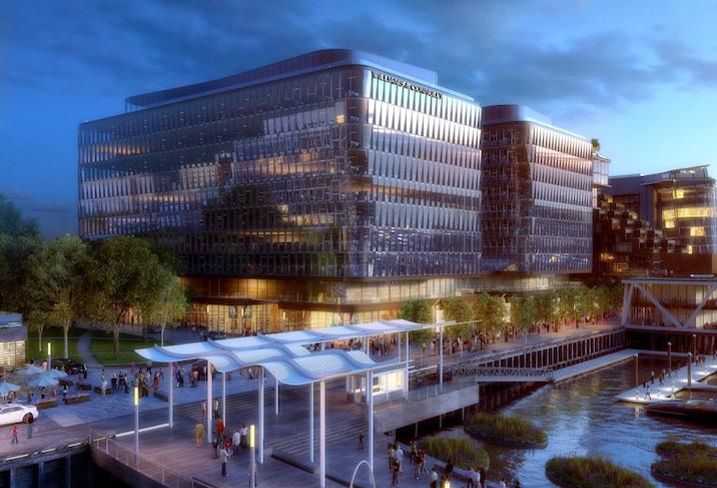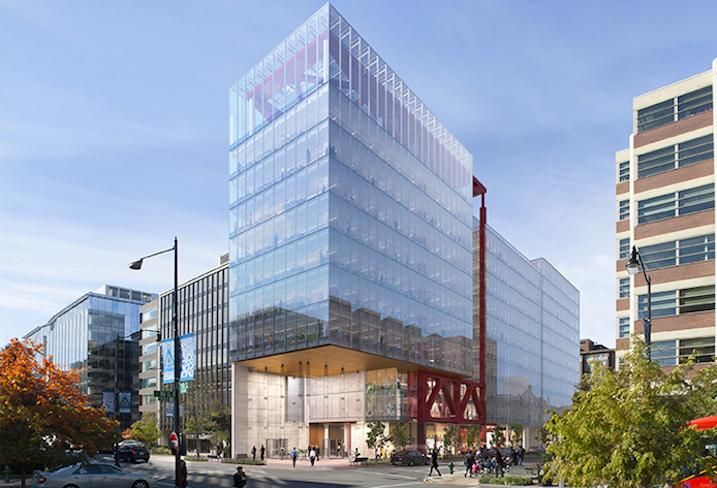July 30, 2019 Jon Banister, Bisnow Washington, D.C.
When Bob Fox began working in D.C. architecture in the 1980s, he said the city had a reputation for conservative design, driven by the presence of the federal government. But he has seen a significant change during this latest development cycle.

Bisnow/Jon Banister -- The Wharf from a water taxi
"I've seen a slow transition where developers have recognized the value of doing good design and pushing the envelope, trying new things and trying to innovate," Fox said. "D.C. has come a long way." No project has exemplified that change more than The Wharf, Fox said. His firm, Fox Architects, designed the 1000 Maine office building in partnership with KPF, making it one of 12 architects that worked on the project's first phase. He said having that range of design perspectives working on the project played a key role in its success. "If you had one firm that did the entire project, it would have been sterile, not as diverse and interesting as it it today," Fox said. "The Wharf is a landmark project for the District and I think it’s obviously been very successful." The master architect who led the group of 12 firms, Perkins Eastman principal Stan Eckstut, said he has been surprised at the response to the project in the nearly two years since it delivered. "It seems to have exceeded my expectations," Eckstut said. He and Fox will speak Aug. 22 at Bisnow's D.C. Architecture & Design Summit. "I didn't think there'd be such a positive reception so soon." The reception has been positive not just from the local community, Eckstut said, but from the larger architecture and development world. He is now working on projects in Dallas, San Juan and Toronto, and he said all of those assignments stemmed from developers seeing the work he did on The Wharf. "People are looking eagerly at this enormously important precedent D.C. has created. There's no other waterfront like it," Eckstut said. "People in other cities are noticing. Clearly from the calls we're getting, they're noticing."

Courtesy of Hoffman-Madison Waterfront -- A rendering of the Parcel 6 and 7 office buildings at The Wharf's Phase 2, anchored by Williams & Connolly
The Wharf's second phase, currently under construction, features a team of 10 architects. It includes prestigious firms coming from other cities such as ShoP Architects, Rafael Viñoly Architects and Morris Adjmi Architects. "Everybody wants to be part of something successful," Eckstut said. "Once you have a successful Phase 1 and have set the tone and vision, there's no reason for continuing the same. You have to explore and interpret other ideas." Part of what makes D.C.'s architecture unique from other cities, Eckstut said, is the District's height limit. Since architects can't design striking towers for the city's skyline, he said they are forced to get more creative with the materials and street-level components of buildings.
"Every time I come to D.C., I'm always impressed by the quality of the buildings and the thoughtfulness and variety of the ideas and interpretations," said Eckstut, who travels between offices in several U.S. cities. "I see more innovation and ideas [in D.C.] than I see in New York and other cities where they might do more with bigger forms that stand out, but I don't find the inventiveness of the materials to be as thoughtful."

Fox Architects, KPF Design Architect -- A rendering of JBG Smith's 1900 N development
Fox is displaying that type of inventiveness with its 1900 N project in Dupont Circle. The JBG Smith development, which Fox is designing alongside KPF, has signed major leases with Goodwin Procter and CBRE. The eastern portion of the building is hung from a truss that will make it appear to be floating, Fox said. "It's got to be one of the most exciting new pieces of architecture in the District right now," Fox said. "I don't think there's another building in the District designed like that." New office buildings in D.C. have begun to break the mold of the traditional glass-box style, and several major out-of-town architects have helped drive D.C.'s office building design forward. Large-scale office buildings such as Midtown Center, designed by SHoP Architects and WDG, and Alexander Court, designed by Pelli Clark Pelli Architects, have introduced distinctive new facades to Downtown D.C. In Northern Virginia, architect Helmut Jahn designed the first office building at the Reston Station development and was recently brought on for the second phase. Fox said the flight of top-tier office tenants to quality new buildings has led to better architecture in that segment, and he expects it will continue to attract big names from other cities. "The commercial office market here has advanced by leaps and bounds," Fox said. "The commercial real estate market certainly appears to be healthy, and it attracts a lot of developers to the area. So I think you're going to continue to see new architects coming in."
